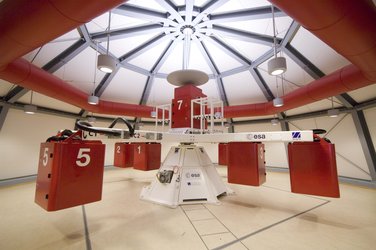Meet the team: Falling Roots (2011)
![]()
![]()
![]()
Chemical signalling in roots under microgravity conditions![]()
| University | University of Florence |
| Endorsing professor | Stefano Mancuso |
| Assistant professor | Elisa Masi |
| Assistant scientist | Elisa Azzarello |
| Team |
Diego Comparini Emanuela Monetti |

The Falling Roots team comprises two students from the University of Florence, Italy, who were selected to develop and perform a microgravity experiment during ESA's Drop your Thesis! 2011 campaign. Their experiment is a continuation of their investigation into how biological processes are affected by microgravity and hypergravity.
Plants have evolved under the constant force of gravity, and its presence strongly influences their growth and development. For this reason, a change in gravitational field strength can be considered as a source of stress that is perceived in the plant’s roots and then transmitted to the other organs by signalling chains, resulting in an adaptation of plant physiology.
When under the stress of microgravity, plants appear to exhibit improved oxygen consumption. This response is postulated to be linked with an oxidative burst, a rapid, transient, production of huge amounts of reactive oxygen species (ROS), which have previously been detected in the apices of plant roots during parabolic flights. These compounds are considered to be important signalling molecules in plants that mediate many developmental and physiological processes.

In this experiment, several roots were placed, together with water, in an array of syringes. The experimental setup was placed in a capsule and suspended at the top of the ZARM drop tower. A few minutes prior to the drop, a plunger depressed several syringes and control samples were collected in small containers. These control samples were later used to determine the level of reactive oxygen species production in roots that have been subjected to all of the same conditions as the test samples, except for microgravity.
The capsule was then dropped. After 3.5-4 seconds of free fall, a second plunger depressed the remaining syringes, expelling the water and all materials excreted by the roots into small sample containers. Due to the reactive nature of ROS, dry ice was used to keep both the test and the control samples cold and to rapidly block all reaction processes. The levels of ROS present in the test and control samples were be determined in a laboratory after the completion of the experiment, using a flourimeter/luminometer. Comparison of the concentration of compounds in the test samples with that in the control samples will permit the acquisition of scientifically significant results on the production of signalling molecules under microgravity conditions.
Read more about this experiment on the ERASMUS Experiment Archive.















 Germany
Germany
 Austria
Austria
 Belgium
Belgium
 Denmark
Denmark
 Spain
Spain
 Estonia
Estonia
 Finland
Finland
 France
France
 Greece
Greece
 Hungary
Hungary
 Ireland
Ireland
 Italy
Italy
 Luxembourg
Luxembourg
 Norway
Norway
 The Netherlands
The Netherlands
 Poland
Poland
 Portugal
Portugal
 Czechia
Czechia
 Romania
Romania
 United Kingdom
United Kingdom
 Slovenia
Slovenia
 Sweden
Sweden
 Switzerland
Switzerland






























